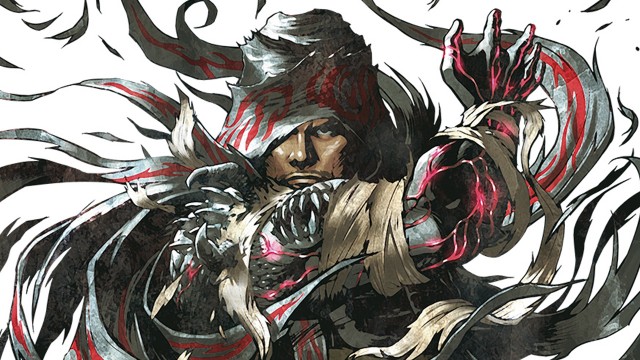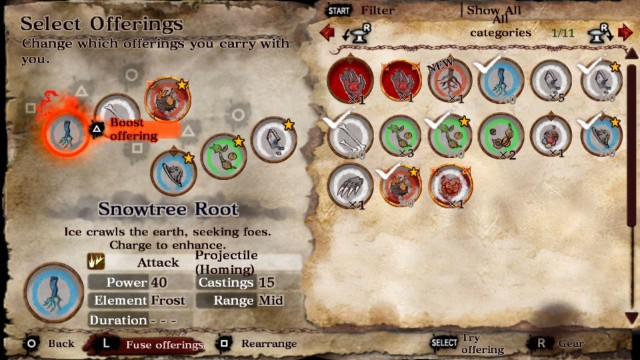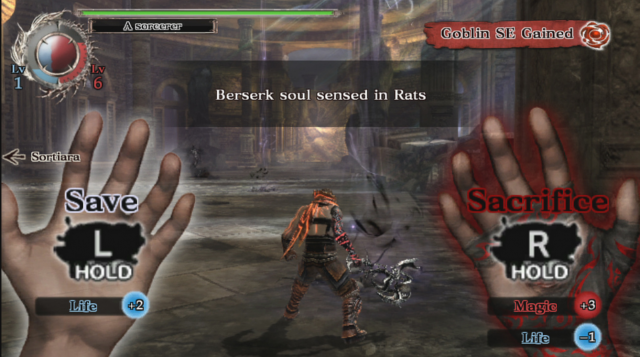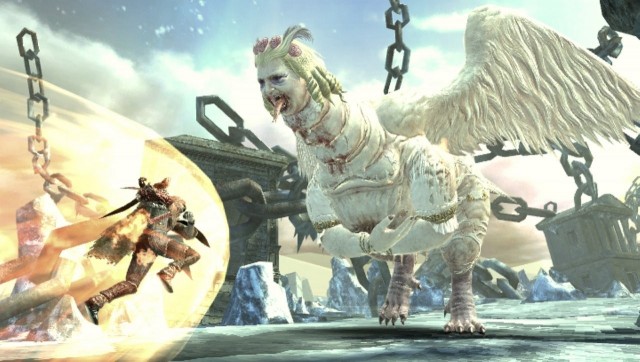We really wanted to like Soul Sacrifice.
We so, so badly wanted to like Soul Sacrifice. The thing is though… We just don’t. The worst part about that is that we can see around every corner that this is an incredible vision with amazing potential. The art design is detailed and breathtaking, particularly when rendered on the Vita’s gorgeous OLED screen! The audio is so harrowing and engrossing. The cutscenes are so cool. The voice acting is so dramatic and gripping. The concept behind the story is incredibly imaginative and wholly unique. But none of it really matters in the end, because the gameplay is an absolute mess!
It’s a little odd to think that Soul Sacrifice’s legion of great ideas is the game’s greatest undoing, but it’s an unfortunate example of too many cooks in the kitchen spoiling the stew. These separate mechanics, of which there are just way too many, just completely fail to come together in any enjoyable way. There is an audience for Soul Sacrifice, and the game can still be appreciated for its ambition, if nothing else, but sadly, the game’s audience is just far too small. This is a game that runs so far with its mechanics of choice and weighing every option to a painstaking degree, that it only really succeeds as a game for micromanagers; People who are absolutely OCD about managing every last little perfect detail of their character, not caring about sacrificing narrative and/or gameplay pace, nor gameplay feedback to do so. If you’re not willing to obsess over every tiny modicum of how your gameplay experience comes together, rather than just try to enjoy a game for what it is, then Soul Sacrifice is not for you. Needless to say, it also comes nowhere close to being the new Vita killer app that so many adopters of Sony’s new handheld had hoped it would be.
When you start Soul Sacrifice, the game wastes no time teasing you with its incredible promise as a concept. You find yourself taken prisoner by the evil sorcerer, Magusar, who sustains himself by devouring human sacrifices. As you await your seemingly inevitable fate, you manage to dig up a talking, organic and sentient book called Librom. Librom proclaims himself as the journal of a forgotten sorcerer, and that he holds the secret to defeating Magusar. Challenging you to read him to the end, Librom allows you to re-live the memories of the journal’s mysterious author, which will allow you to learn how to become a great sorcerer, possibly allowing you to learn magic, stand against Magusar, and escape your dire predicament with your life.
Doesn’t that sound awesome?! Unfortunately, Librom isn’t kidding when he talks about how he’s not easy to read. Immediately, the game heaps a mountain of choice and customization mechanics on you. The game is at least decent enough to explain its fundamentals and mechanic definitions to you, but after that, you’ll find that all of the knowledge can be very difficult to apply and keep straight with any reasonable degree of assurance. Soul Sacrifice has so many neat gameplay ideas, but it actually has too many of them in the end. The result is a gameplay experience that is so cool on paper, but is far too convoluted and tedious to be enjoyable past the first moments.
We will say that the way Soul Sacrifice is set up is quite well suited to a handheld platform. Assuming you can figure out this slovenly heap of gameplay mechanics, you’ll play through a series of brief missions, maybe lasting anywhere from two to five minutes most of the time, which take the form of journal entries. This makes Soul Sacrifice well-suited to portable play that can be easily chunked, and easily taken on the go. Unfortunately, even if the structuring is fine, most players will quickly be lost past the initial few missions, since Soul Sacrifice gives you absolutely no feedback whatsoever. Most players will never be quite sure if they’re playing it properly, and that’s made worse by the fact that Soul Sacrifice demands grinding, which is a large part of what kills the experience. In fact, there’s never any warning that you’ll most certainly need to go back and grind your stats, leaving several sections in the storyline where the difficulty curve will suddenly spike without warning, forcing you to try and go back to build up the means to progress. We can respect that not every game wants to hold the player’s hand all the way through it, but there’s a difference between giving a player freedom, and just not giving them a clear idea of how they’re supposed to play the game. The latter is never good, even in a game mainly driven by choice.
Most of these choice mechanics come from a decision to either ‘Save’ or ‘Sacrifice’ defeated monsters. If you’ve played games like BioShock or Dante’s Inferno, it’s pretty much the exact same idea. Deciding the fate of a monster in either direction has benefits that may be necessary at certain moments. Saving a monster can restore some of your health, and may make certain monsters join up with you later, but sacrificing it can restore the energy of your Offerings, which are the spells you use in battle, and eventually, they run out of juice, and even break. Deciding whether to Save or Sacrifice a monster isn’t as in-depth as you may imagine, since you’ll just do whatever is necessary at that moment in gameplay, without really thinking of the ramifications of what you’re doing beyond that. To track your progress, you’ll gain EXP for one of two separate character levels, which are boosted as you Save and Sacrifice a certain amount of monsters. The combined levels are essentially your character’s base level, if you want to fully think of Soul Sacrifice as an action-RPG, which is the closest classification that makes sense.
This mechanic is probably the most inspired in the game, even if the intended ethical dilemma of Saving or Sacrificing is largely swept under the rug, because all players will care about is building up their character in one direction or the other, or both. It’s still a cool idea though. What makes it even better is that certain NPC’s, whether they’re sorcerers or rescued monsters, may or may not join you depending on whether you’ve Saved or Sacrificed more frequently. Likewise, Saving an ally that would rather be Sacrificed may cause them to distrust you, and voluntarily walk out of your party. This is where the choice mechanic should have ended. It’s an inspired and creative way to give your decisions weight, and give you a great way to customize your character, beyond just a base and token good/evil designation.
Unfortunately, the game runs even further with the choice mechanic, and ends up running too far with it. The worst result of this is the Offerings. The Offerings, again, are a cool idea on paper, but in execution, managing them is an incessant and unforgiving pain in the ass. Figuring out which Offerings are useful and which are not is a painstaking and drawn-out matter of trial-and-error. Figuring out how to use them properly takes even more time. Worst of all, they break. Yes, they break! If you use an Offering too much, it becomes permanently unuseable, at least until you fix it, and we’ll get to that. Perfect. This means you could very easily leave yourself screwed during one of the game’s many highly challenging boss encounters, simply because you used up all of your Offerings trying to kill the beast. You can try to turn the tide by tapping an icon on the Touch Screen that lets you use a Black Rite as a last resort, another inspired risk/reward system that causes hefty damage to enemies, but will reduce your stats or otherwise hamper your abilities. The effect is also permanent until you find a way to reverse it by spending Lacrima, but we’ll get to Lacrima.
And it gets worse too. Even if you happen to fall into the game’s niche target audience of unrepentant micromanagers, even you won’t be able to defend the fact that Soul Sacrifice’s targeting system is completely broken. You can use the L button to try and zero in on a certain foe, but whether you lock on to that foe, or some distant object miles into the background, is a crapshoot. Even when you are locked on, the lock-on disengages extremely easily, especially with some enemies’ irritating tendency to flee and constantly be out of reach. The flying enemies are the worst offenders here, really needing a design tweak to make them less irritating and cowardly! If you just try to ignore the lock-on system, you’ll find that your character constantly flings spells in the wrong direction as well. Recall that the game’s Offerings are breakable with a handful of uses. If your intuition is telling you that the combat in Soul Sacrifice is frequently aggravating, then good news, your intuition still works!
There is one saving grace with the Offerings however, and that’s Lacrima. What’s Lacrima, you ask? Well, every so often, Librom will ‘cry’, even though he claims that it’s not tears (whatever, Librom), and when you slide your finger underneath Librom’s eye on the Touch Screen, you’ll collect the ‘tears’, which are ‘Lacrima’. Lacrima is spent whenever you want to ‘rewrite’ a small event in the journal. You can change whether you Saved or Sacrificed an Archfiend (Archfiends serve as the game’s bosses for the most part), which changes some events in the journal depending on the decision you made, but most importantly, spending Lacrima is the only way to restore broken Offerings. You’ll almost always pump all of it into restoring the Offerings you’ve spent, which becomes tedious very quickly. Frankly, either the game should have had destructible, but simple weapons, or the existing system where the weapons don’t break; Not both! The fact that Soul Sacrifice forces you to juggle all of this with the Offering mechanics is yet another reason why the gameplay quickly becomes frustrating and tedious!
What’s most frustrating about the combat however is that the bosses in Soul Sacrifice are actually nicely domineering and well-designed. The problem is actually fighting them, dealing with a glitchy targeting system and destructible spells all the while. Of course, this is made even worse by the fact that Soul Sacrifice doesn’t give you a clear idea of how well you’re playing it. If you get stuck, and you will get stuck, you’ll have no idea of whether you just need to build more levels, accumulate more Offerings, boost or fuse an Offering (because, you know, Offerings weren’t already irritating and vague enough as a mechanic, so why not force players to memorize a bunch of upgrade recipes too?!), or whether you just need to modify an existing combat strategy. It doesn’t matter how many great ideas went into the combat. It’s all killed by the fact that what is supposed to be the centerpiece of the game, the choice-driven struggle against legions of twisted monsters, is just not fun or enjoyable.
You can try to increase the fun by recruiting up to three other players to fight alongside you online, but playing with strangers doesn’t really improve matters. You have a series of simple text commands as your sole means of communicating with anyone that isn’t on your PlayStation Network friends list, and while these are good enough in some situations, such as whether you want an ally to Save or Sacrifice you upon death, there’s also times where you’ll wish that the game offered a more accessible voice chat option. As you can imagine, online strangers are often far from co-operative as well. They’ll often just go and do their own thing, with only a rare few bothering to help you out in a pinch, or actually assist you with developing your own character. It’s not difficult to leap into a smoothly-connected online session and enlist some allies, but if they’re not already your friends, it’s sadly not really worth it to do so. Players can share Offerings with the Vita’s Near functionality as well, but that depends on players in your vicinity playing a game that is really not very crowd-pleasing, and likely won’t have more than a select cult following. You also won’t be able to do this if you didn’t activate an online pass, which is also necessary to access the co-op functionality at all. Really? Soul Sacrifice needs an online pass?
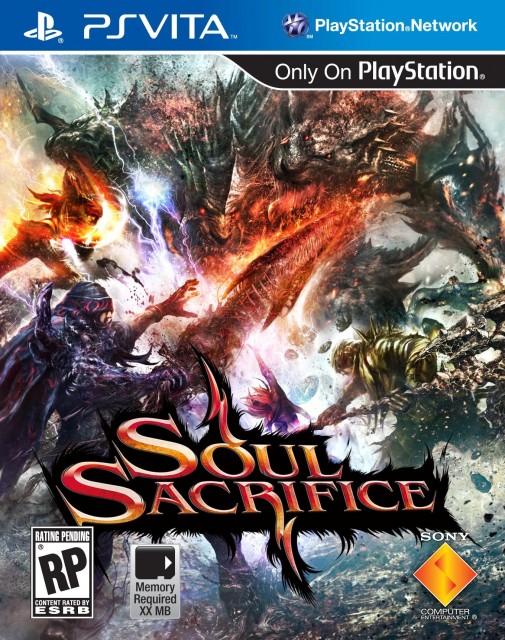 Anyway, if you’re playing with your PlayStation Network friends, you can at least use party chat if you have a Vita-capable headset, but you won’t have this option if you just try to hop into a session with other players. There’s one potentially interesting idea that’s especially helpful with your friends however, where, if you ‘Choose Death’ upon losing all of your health, you can become a ghost that can boost allies and stymie enemies as the defeated player taps their allies and enemies on the Vita’s Touch Screen. It’s interesting, and it can be a helpful way to stay in the game if you find your party’s numbers dwindling during a tough battle. It is entirely possible to beat Soul Sacrifice without ever touching the co-op however, and if you don’t have any friends that own a Vita, you’re still likely not going to bother playing with other people.
Anyway, if you’re playing with your PlayStation Network friends, you can at least use party chat if you have a Vita-capable headset, but you won’t have this option if you just try to hop into a session with other players. There’s one potentially interesting idea that’s especially helpful with your friends however, where, if you ‘Choose Death’ upon losing all of your health, you can become a ghost that can boost allies and stymie enemies as the defeated player taps their allies and enemies on the Vita’s Touch Screen. It’s interesting, and it can be a helpful way to stay in the game if you find your party’s numbers dwindling during a tough battle. It is entirely possible to beat Soul Sacrifice without ever touching the co-op however, and if you don’t have any friends that own a Vita, you’re still likely not going to bother playing with other people.
The developers can throw as many mechanics as they deem necessary into Soul Sacrifice, but none of it means anything when it simply results in a game that is not fun. As much as we wanted to like this game, we can’t deny that the end result for most players will just be frustration, tedium and confusion. The game may be creative and ambitious, but it’s not at all user-friendly, and it squanders its concept on an overstuffed set of choice mechanics that just makes Soul Sacrifice collapse under its own weight, even early on. There is an audience for this kind of game, but a very niche audience. Masochists and obsessive micromanagers will likely enjoy the experience, but they’re likely going to be the only ones. Soul Sacrifice does have potential as a cult favourite, we won’t deny that, but this game isn’t in spitting distance of being a killer app for the Vita, even with all of its impressive production values.
If you’re a frustrated and game-starved Vita player, we understand your pain. Good Vita games are sadly few and far between at present, and most Vita loyalists will probably just want to take what they can get. Unfortunately, Soul Sacrifice will only make those Vita pains worse if you don’t fall into its very tiny target audience, since it’s just a mess of botched potential and infuriating gameplay in the end. Yes, it’s undeniably beautiful, it’s loaded with creativity, and it will be truly engrossing for that niche gamer. For most though, Soul Sacrifice is just too punishing and unfriendly to be worth playing. If you’re seeking a killer app that will really make you feel great about investing in a Vita, this really isn’t it. We would recommend LittleBigPlanet PS Vita to that end instead, if you haven’t already played it.
It just goes to show; all of the gameplay ideas in the world can’t save a game that just isn’t fun…


